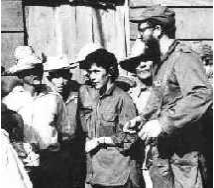Celia Sánchez

Celia Sánchez Manduley (alias Norma) (born May 9, 1920 in Media Luna , Cuba ; † January 11, 1980 in Havana ) was a Cuban revolutionary and politician, companion and life companion of Fidel Castro .

Life
Celia Sánchez grew up in the extreme southwestern tip of eastern Cuba in what was then the province of Oriente (now the province of Granma ); first in Media Luna , from 1940 in nearby Pilón , later in Manzanillo . She was born into an anti - imperialist family. Her father, the doctor Manuel Sánchez, was a member of Eduardo Chibás's Orthodox party, of which Fidel Castro was a member at the time.
On 28 January 1953 the 100th anniversary of José Martí (1853-1895), Celia will together with her father a bust of Cuban national hero of the highest mountain of Cuba, the Pico Turquino ( 1974 m in) Sierra Maestra have managed . The inscription on the bust is said to have read: "As rare as the mountains are the people who can look down from them". This was intended to send a silent signal against the extreme social inequality in Cuba and against the Batista regime, which was partly to blame by US companies . From then on, her life was entirely devoted to the struggle against dictator Batista and, after the victory of the revolution, to political work in the new Cuba. She died of cancer on January 11, 1980 in Havana .
Political activity
Batistas expelled
On July 26, 1953, the young lawyer Fidel Castro attacked the Moncada barracks in Santiago de Cuba . At that time, Celia was already agitating among the poorest sections of the population in the region around Manzanillo against the authoritarian Batista regime and for social justice.
Despite its failure, the attack on the Moncada barracks was the beginning of the liberation struggle, in which Celia also took part in the period that followed. First, she helped the revolutionaries around Fidel Castro while they were in custody. She later became the founder and leader of the " July 26th Movement " in the Manzanillo area. In the underground she later prepared the arrival of the 82 revolutionaries around Fidel and Raúl Castro as well as Che Guevara with the yacht " Granma " on December 2, 1956 in Cuba, not least because she knew the area very well as it was close to the landing site , Playa Las Coloradas . Even before the group left Mexico, Celia helped organize a first retreat for the revolutionaries in the nearby Sierra Maestra after they landed in Cuba.
During the first guerrilla days in Cuba, she organized the first reinforcement contingent alongside Frank País , which rose to the rebels in the Sierra Maestra ( Los Marabuzaleros ) by January 6, 1957 . She also organized supplies with weapons, food and medicine. On February 16, 1957, Celia first met Fidel Castro . In the following years she became the contact person between the rebels in the mountains of the Sierra Maestra and the comrades operating underground in the plain. On March 19, 1957, Celia was the first woman to join the rebel army in the Sierra Maestra. She experienced her baptism of fire on May 28, 1957, when the rebels took the heavily secured barracks of the Batista Army in Uvero . In October 1957 she became the first guerrilla member of the general command of the rebel army . She became one of the driving forces behind the establishment of an all-women troop, which was then realized under the name " Mariana Grajales " (the mother of General Antonio Maceo ). Until after the rebel victory against Batista, Celia Sánchez always worked closely on Fidel Castro's side. So she moved into Santiago de Cuba next to Fidel on January 1, 1959 .
"Natural historian"
During her time in the General Command, she wrote detailed reports on all important incidents in the course of the civil war, which were of inestimable value, not least for the continuation of the fighting. On the other hand, she has collected documents, messages and notes and kept them in her backpack. When she founded the History Office of the State Council on May 4, 1964 , she practically brought her work to a close: The preservation of the authentic documents of a successful guerrilla.
Building the new Cuba
After the victory of the revolution in early 1959, she held various offices at the side of Comandante en Jefe Fidel Castro. She was a member of the Central Committee of the Communist Party ( Spanish Partido Comunista de Cuba , abbreviated PCC ), deputy in the National Assembly of People's Power ( Spanish Asamblea Nacional del Poder Popular ) and secretary of the State Council. In these offices she played a key role in many state and party decisions. She is still very much revered in Cuba today.
Web links
- Linda Pressly: Celia Sánchez ¿fue amante de Castro? in: BBC Mundo of December 11, 2011, accessed December 11, 2011 (Spanish)
literature
- Rich Haney: Celia Sanchez: The Legend of Cuba's Revolutionary Heart. Algora Publishing, 2005, ISBN 978-0-87586-395-5
- Julia E. Sweig: Inside the Cuban Revolution: Fidel Castro and the Urban Underground. Harvard University Press, Harvard 2002, ISBN 978-0-674-00848-9
- Ernesto Guevara : Cuban Diary ("Pasajes de la Guerra Revolucionaria. Cuba 1959-1969"). Kiepenheuer & Witsch, Cologne 2008, ISBN 978-3-462-04040-1 .
| personal data | |
|---|---|
| SURNAME | Sánchez, Celia |
| ALTERNATIVE NAMES | Norma; Sánchez Manduley, Celia |
| BRIEF DESCRIPTION | Cuban revolutionary and politician |
| DATE OF BIRTH | May 9, 1920 |
| PLACE OF BIRTH | Media Luna |
| DATE OF DEATH | January 11, 1980 |
| Place of death | Havana |
